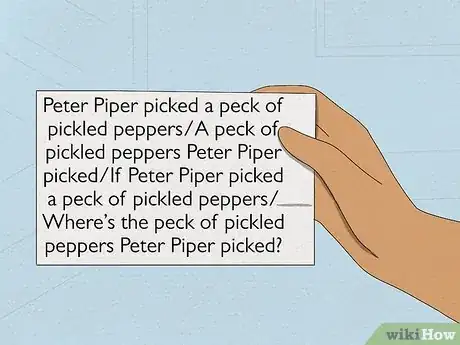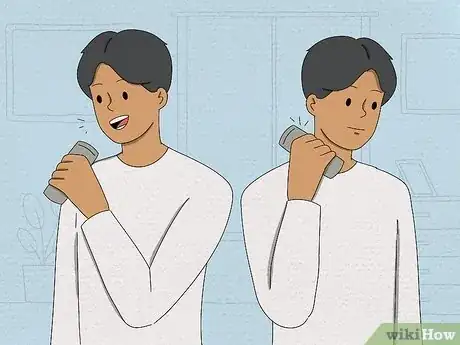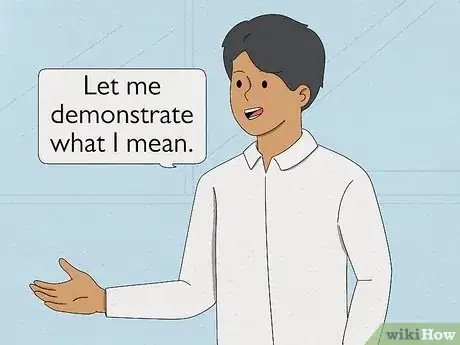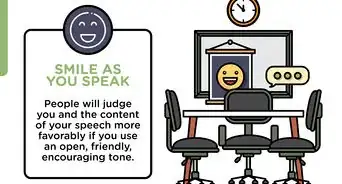This article was co-authored by Patrick Muñoz. Patrick is an internationally recognized Voice & Speech Coach, focusing on public speaking, vocal power, accent and dialects, accent reduction, voiceover, acting and speech therapy. He has worked with clients such as Penelope Cruz, Eva Longoria, and Roselyn Sanchez. He was voted LA's Favorite Voice and Dialect Coach by BACKSTAGE, is the voice and speech coach for Disney and Turner Classic Movies, and is a member of Voice and Speech Trainers Association.
There are 8 references cited in this article, which can be found at the bottom of the page.
wikiHow marks an article as reader-approved once it receives enough positive feedback. This article has 15 testimonials from our readers, earning it our reader-approved status.
This article has been viewed 289,897 times.
Talking fast can be a powerful tool, especially when it is done with confidence. Maybe you want to learn how to talk faster in casual conversation so you can eliminate your slow talking habit. Or, perhaps you want to talk faster when doing presentations or talks for an audience so you appear more persuasive and engaging. No matter the issue, you can learn to talk faster with the right method and steps.
Steps
Practice Exercises
-
1Read a text out loud at varying speeds. You can do speed talking drills to improve your ability to speak quickly and clearly. Do this by reading an example passage from a book that contains challenging terms or by using original writing that contains terms you want to get better and faster at saying out loud.[1]
- Start by reading the text out loud at a normal speed. Then, read the same passage again at a slightly faster speed. Repeat this again, reading the passage at an even faster speed. This can help you get your eyes and mouth to work together at faster speeds.
- You can also try reading the passage backwards, starting from the end of the passage and moving backwards to the beginning of the passage. This drill will help you get used to reading out loud quickly, as you will not have to pause to take extra time to think about what you are saying out loud.
-
2Insert words in a passage and read it out loud. You can also try inserting a word between each word when you read a passage out loud, such as “and” or “the”. For example, the phrase, "The dog walked down the street" can be read as "The and dog and walked and down and the and street and."[2]
- Inserting a word between the words in the passage will force you to simply read the text without having to think about what it means, which will then allow you to speak faster. It also gives your speech a certain rhythm and diction that you can then translate to other texts and instances when you have to speak fast.
Advertisement -
3Practice tongue twisters. Tongue twisters can help you get better at enunciating your words and talking smoothly. They are also good for getting better at flow and clarity as you speak faster.[3]
- You can use familiar tongue twisters, such as “Peter Piper picked a peck of pickled peppers/A peck of pickled peppers Peter Piper picked/If Peter Piper picked a peck of pickled peppers/Where’s the peck of pickled peppers Peter Piper picked?”[4]
- If you struggle with words that begin with a certain letter, such as “j” words, you may want to try a tongue twister that features the letter “j”, such as “James just jostled Jean gently. Jack the jailbird jacked a jeep.”[5]
- Try to practice three to four different tongue twisters a day, saying them out loud at faster and faster speeds. You may also want to time yourself as you say the tongue twisters so you can track how fast and how well you can say them as you practice them every day.
- Tongue twisters are also great warm up tools for when you are about to talk to others and want to speed up your talking speed. Try to repeat one to two tongue twisters to yourself to get used to talking faster once you are around others.
-
4Try speaking with a pen in your mouth. Though you may look silly to your friends, speaking with a pen or pencil in your mouth can help you improve the clarity and speed of your speech. Hold the pen or pencil horizontally in your mouth between your back teeth. Then, practice reading a passage or text out loud.[6]
- Try to articulate every word as you read out loud, even if it may be difficult due to the pen. This drill will force your tongue to work harder and allow you to get used to over-articulating your words. You will also develop exaggerated mouth and facial movements, which can allow you to become a more engaging speaker.
-
5Reduce the use of “filler words” in your speech. Filler words are terms that you tend to say when you are thinking of what to say next or when you are nervous. Words like “uh”, “um”, “like”, and “you know” do not hold any meaning and will slow you down when you are trying to talk quickly. You should work on reducing or removing these words from your speech.[7] [8]
- Try to remind yourself not to use “like” or “um” when you speak to others. You may need to get in the habit of pausing for a breath whenever you feel the urge to use these filler words. Over time, you can then fill in the pauses by flowing from one meaningful word to the next, without filler words.
- You can also try the rubber band method, where you put a rubber band on your wrist. Every time you say a filler word, you can gently slap your wrist with the rubber band. Over time, you should remember to avoid using filler words for fear of getting a rubber band slap.
- Some filler words are redundant and meaningless, leading to greater confusion when you speak to others. Try to avoid filler words like “actually” or “in fact”, such as “The sky was actually blue yesterday” or “In fact, I know the answer.” Removing these terms can make your speech clearer and more concise.
Giving Presentations and Speeches Faster
-
1Warm up your vocal chords before a presentation or talk. You should give yourself ten to fifteen minutes before a presentation to warm up your voice and prepare your vocal chords for some fast talking. You can do this by doing some common warm up vocal exercises, including:
- Close your lips and force air between them until you make a horse-like noise. Your lips should vibrate together and make neighing sounds or noises. This can help to loosen up the muscles around your mouth.
- You can also do face stretches to get the muscles in your face ready for fast talking. Do this by trying to get your mouth, nose, and eyebrows as close together as possible. Then, try to get them as far apart as possible. Stick your tongue out while you do this.
-
2Record yourself as you practice the presentation. You can determine how slow you speak by recording yourself talk out loud. You may set up a tape recorder and record yourself as you pretend to present your speech in front of a mirror.[9]
- Listen to the playback of your presentation and note if you slow down in particular areas of your speech. Focus on speeding up your delivery in these spots the next time you practice the speech.
- You should also be on the look out for any filler words, such as “um” or “ah”. Try to remove them the next time you practice the speech. Focus on saying the word before and the word after the spot where you used a filler word so you are not prone to using them.
-
3Replace words you find difficult to pronounce. You may also notice that you are stumbling over certain words when you read your speech out loud. You should consider replacing terms that are tricky for you with simplified terms or terms that you are more familiar with. This will also allow you to speak faster, as you will not have to consider unfamiliar words when you present your speech.[10]
- For example, you may replace a term like “utilize” with the more simplified term, “use”. Or, you may replace a more academic phrase like “let me solidify my point” with a more simplified phrase, “let me demonstrate what I mean”.
- You may also notice that certain sections of your speech appear wordy or long winded. You may decide to cut out certain words and revise the speech so it is shorter and easier to say. Often, shorter is better for speeches and talks.
-
4Use your hands when you speak. You can also use other parts of your body, like your hands, to help you maintain a steady speaking pace. You may gesture with your hands to highlight a point or walk slowly back and forth across the room to emphasis your speech. Use your hands and your body to help you keep up a certain rhythm and pace to your speech.[11]
- You should also demonstrate positive body language when you are giving a presentation or a speech. This means maintaining eye contact with your audience and positioning your body to face your audience.[12]
Community Q&A
-
QuestionHow can I become a great English speaker?
 Community AnswerRead books in English, watch TV and movies in English, and speak with people in English (ideally native speakers) as often as possible.
Community AnswerRead books in English, watch TV and movies in English, and speak with people in English (ideally native speakers) as often as possible. -
QuestionHow do I improve my pronunciation of words?
 Community AnswerTry to imitate native speakers and practice speaking the long sentences word by word. The more you practice, the easier it will become.
Community AnswerTry to imitate native speakers and practice speaking the long sentences word by word. The more you practice, the easier it will become. -
QuestionDoesn't fast talking make you say mixed up words and cause stuttering?
 Community AnswerIt can, but it doesn't always. Obviously there are occasions where it's important to speak slowly, but if you practice fast-talking you will get better at it and there will be less chance of stuttering.
Community AnswerIt can, but it doesn't always. Obviously there are occasions where it's important to speak slowly, but if you practice fast-talking you will get better at it and there will be less chance of stuttering.
References
- ↑ http://debate-central.ncpathinktank.org/the-best-speaking-drills-and-when-to-do-them/
- ↑ http://debate-central.ncpathinktank.org/the-best-speaking-drills-and-when-to-do-them/
- ↑ http://www.write-out-loud.com/dictionexercises.html
- ↑ http://www.engvid.com/english-resource/50-tongue-twisters-improve-pronunciation/
- ↑ http://www.write-out-loud.com/dictionexercises.html
- ↑ http://debate-central.ncpathinktank.org/the-best-speaking-drills-and-when-to-do-them/
- ↑ http://www.fastcompany.com/3051834/know-it-all/these-six-filler-words-are-undermining-your-credibility
- ↑ https://www.scotthyoung.com/blog/2008/03/18/12-speaking-errors-that-make-you-sound-stupid/
- ↑ https://www.panopto.com/blog/the-single-greatest-secret-to-delivering-a-perfect-presentation-record-yourself-practicing/
About This Article
To talk faster, practice reading a passage of text aloud at increasing speeds. You can also practice saying tongue twisters at different speeds, which will help you enunciate words at a faster pace. When you’re speaking normally, try to reduce filler words, like “Um,” “Like,” and “You know,” which slow your speech down and don’t add any meaning. If you’re practicing a presentation, record yourself giving the speech and listen back to it. Notice phrases or sentences where you slow down, then practice saying those bits to increase your speed. If there are difficult words to pronounce that slow you down, consider switching them for easier alternatives. For more tips, including how to warm up your vocal cords before a speech, read on!







































































